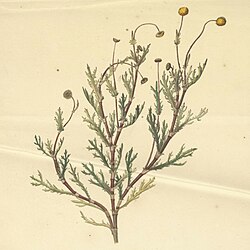Biology:Cotula anthemoides
| Cotula anthemoides | |
|---|---|

| |
| Scientific classification | |
| Kingdom: | Plantae |
| Clade: | Tracheophytes |
| Clade: | Angiosperms |
| Clade: | Eudicots |
| Clade: | Asterids |
| Order: | Asterales |
| Family: | Asteraceae |
| Genus: | Cotula |
| Species: | C. anthemoides
|
| Binomial name | |
| Cotula anthemoides | |
Cotula anthemoides is a species of flowering plant in the Aster family that is widely distributed across Africa and southern Asia. It has also been introduced to Albania, France, and Poland.[1]
Description
The species grows across the ground, with the ends of the branches sometimes growing upright. It lacks hairs and has several branches up to 20 centimeters long. The leaves have small stalks and are a stretched oval shape, around 2–4 cm long and 1.5–3 cm wide. The capitula are roughly globe-shaped and yellow, with a diameter of 4–6 mm. Each capitulum is solitary on its own thread with stalks 4–5 cm long. The whorl of bracts below the flowers is more or less saucer shaped. The outer florets make a very small corolla, while the disc-florets are twice as long. The fruits are oval shaped and around 1 mm long, with narrow wings and a pale-brown color. The plant flowers from March to June.[2]
Taxonomy
Cotula anthemoides was first formally described by Carl Linnaeus in 1753 in Species Plantarum. Linnaeus gave the following brief description for the species:[3]
Synonyms
The following synonyms are accepted according to Plants of the World Online:[1]
| Name | Author | Year | Journal | |
|---|---|---|---|---|
| Homotypic | Lancisia anthemoides | (L.) Moench | 1802 | Suppl. Meth. |
| Pleiogyne anthemoides | (L.) K.Koch | 1843 | Bot. Zeitung (Berlin) | |
| Heterotypic | Artemisia nilotica | L. | 1755 | Cent. Pl. I |
| Cenia microcephala | E.Mey. ex DC. | 1838 | Prodr. | |
| Cotula dichrocephala | Sch.Bip. ex A.Rich. | 1848 | Tent. Fl. Abyss. | |
| Cotula microcephala | DC. | 1838 | Prodr. | |
| Nananthea tassiliensis | Batt. & Trab. | 1913 | Bull. Soc. Bot. France | |
| Pleiogyne cardiospermum | Edgew. | 1846 | Trans. Linn. Soc. London | |
| Pleiogyne microcephala | K.Koch | 1843 | Bot. Zeitung (Berlin) |
Uses
The flower heads are used in traditional medicine to treat rheumatic pain. A poultice is created by crushing the flower parts into powder and then warming them with oil.[2]
References
- ↑ 1.0 1.1 "Cotula anthemoides L. | Plants of the World Online | Kew Science" (in en). http://powo.science.kew.org/taxon/urn:lsid:ipni.org:names:198423-1.
- ↑ 2.0 2.1 "Cotula anthemoides in Flora of Pakistan @ efloras.org". http://www.efloras.org/florataxon.aspx?flora_id=5&taxon_id=200023720.
- ↑ Linné, Carl von (1753). Species plantarum: exhibentes plantas rite cognitas ad genera relatas, cum diferentiis specificis, nominibus trivialibus, synonymis selectis, locis natalibus, secundum systema sexuale digestas. 2. https://www.biodiversitylibrary.org/item/84236#page/337/mode/1up.
Wikidata ☰ Q15240254 entry
 |

